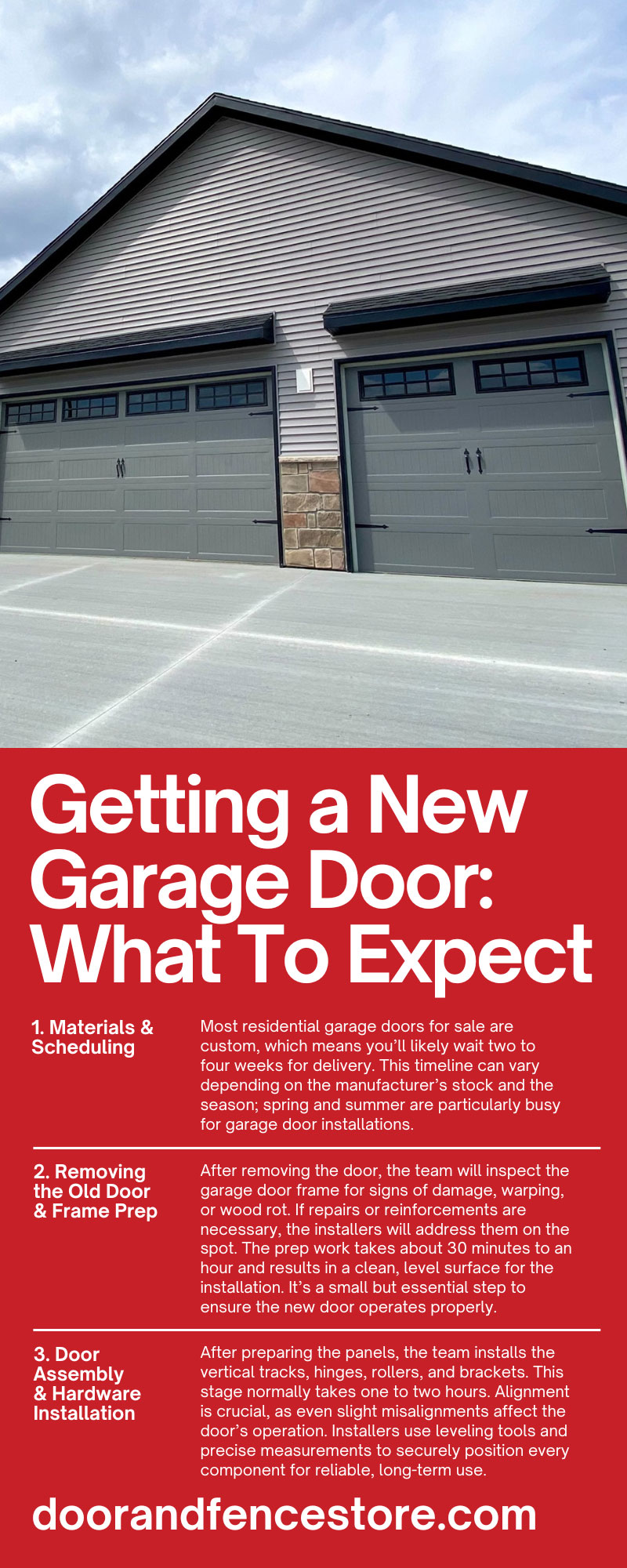A garage door is one of the most used and visible features of the home, so it should be in good shape. Many homeowners are unsure of what to anticipate when installing a new garage door. How long does it take? What does the process involve? How much disruption should they prepare for?
We’ll break down what to expect when getting a new garage door, from the initial phone call to the final safety test, so that you can move forward with confidence.
1. Materials & Scheduling
Choosing the right garage door material and style is the first step. Many homeowners choose from steel, aluminum, or wood options, each with its own benefits in terms of durability and appearance.
Most residential garage doors for sale are custom, which means you’ll likely wait two to four weeks for delivery. This timeline can vary depending on the manufacturer’s stock and the season; spring and summer are particularly busy for garage door installations.
The installation typically occurs after the door arrives and you and the installers have secured any necessary permits. Local codes or homeowners association (HOA) rules may require approval, which an installer can help you navigate.
Clear communication at this stage is crucial to set an installation date that works with you. Preparing your garage space ahead of time will also help the installation crew work efficiently on the big day.
2. Removing the Old Door & Frame Prep
On installation day, the first task is removing the existing garage door. This process usually takes between one and two hours and involves carefully detaching the door panels, disconnecting the springs, and disassembling any remaining hardware.
After removing the door, the team will inspect the garage door frame for signs of damage, warping, or wood rot. If repairs or reinforcements are necessary, the installers will address them on the spot. The prep work takes about 30 minutes to an hour and results in a clean, level surface for the installation. It’s a small but essential step to ensure the new door operates properly.
3. Door Assembly & Hardware Installation
Next, the installers begin assembling the new garage door panels. Depending on the style and material, this process typically takes one to two hours. Sectional doors come together panel by panel, and installers will add insulation and decorative elements as needed. If you selected a door with windows or custom features, assembly time may run slightly longer.
After preparing the panels, the team installs the vertical tracks, hinges, rollers, and brackets. This stage normally takes one to two hours. Alignment is crucial, as even slight misalignments affect the door’s operation. Installers use leveling tools and precise measurements to securely position every component for reliable, long-term use.
4. Mounting Door & Springs
When the tracks and hardware are in place, the garage door is ready for mounting. Mounting involves carefully positioning the assembled panels into the tracks and securing them with hinges and rollers. This methodical process takes one to two hours, depending on the size of the door and its features.
Next, installers proceed to install the springs, either torsion or extension types, depending on the system. Installing and adjusting these high-tension components is technical and critical to safety.
Springs usually take about an hour, and improper handling can cause injury or premature wear. A professional team will carefully balance the door so that it opens with minimal effort and remains in position when raised.
As part of this phase, the pros will install weather stripping along the sides and bottom of the door. These seals prevent drafts, moisture, and debris from entering the garage. A seal also maintains indoor temperatures, which is particularly valuable if the garage is attached to the home or used as a conditioned space.
5. Garage Door Opener Setup
If you’re replacing or adding a garage door opener, this step adds two to three hours to the project. The opener is mounted to the ceiling and connected to the door via an arm and bracket system. Installers also set up the rail, trolley, and belt or chain mechanism, depending on the model. They will configure wireless keypads, remote controls, and in-garage buttons at this time.
Safety sensors go near the bottom of the tracks to detect obstructions and reverse the door if needed. If you opted for a smart garage door opener, installers will connect it to your home Wi-Fi for app-based control. This is a good time to ask questions about features like vacation lock mode or quiet operation settings.
6. Testing & Final Adjustments
The last step is a full system test. The crew will open and close the door several times, checking for smooth movement, balance, and full range of motion. They’ll also verify that the door seals at the bottom. This is especially important if the garage floor isn’t perfectly level. This testing phase typically takes 30 minutes to an hour.
Fine-tuning is also part of the process. Installers adjust spring tension, realign safety sensors, and program the opener to stop and reverse if something blocks its path. In addition, they’ll walk homeowners through opener usage, reset remotes, and basic maintenance, such as lubricating hinges or checking door balance every few months.
7. After Installation
Once testing is complete, you can expect a quick walkthrough and a few final notes on warranty and support. An installer may leave behind documentation for the opener, maintenance tips, and contact information for future service. From removal to final test, the entire installation takes between 6 and 12 hours. It’s a full-day project that delivers an immediate upgrade in the safety, function, and curb appeal of your home.
One final thing to expect when getting a new garage door is a smoother experience. Central Iowa homeowners have put their trust in The Door & Fence Store for decades. We handle everything—from product selection and scheduling to expert installation—with attention to detail and respect for your time. Now that you know what to expect when getting a new garage door, you’re ready to update yours!









